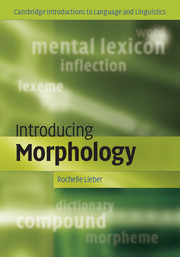Book contents
- Frontmatter
- Contents
- Preface
- The International Phonetic Alphabet
- Point and manner of articulation of English consonants and vowels
- 1 What is morphology?
- 2 Words, dictionaries, and the mental lexicon
- 3 Lexeme formation: the familiar
- 4 Productivity and creativity
- 5 Lexeme formation: further afield
- 6 Inflection
- 7 Typology
- 8 Words and sentences: the interface between morphology and syntax
- 9 Sounds and shapes: the interface between morphology and phonology
- 10 Theoretical challenges
- Glossary
- References
- Index
7 - Typology
- Frontmatter
- Contents
- Preface
- The International Phonetic Alphabet
- Point and manner of articulation of English consonants and vowels
- 1 What is morphology?
- 2 Words, dictionaries, and the mental lexicon
- 3 Lexeme formation: the familiar
- 4 Productivity and creativity
- 5 Lexeme formation: further afield
- 6 Inflection
- 7 Typology
- 8 Words and sentences: the interface between morphology and syntax
- 9 Sounds and shapes: the interface between morphology and phonology
- 10 Theoretical challenges
- Glossary
- References
- Index
Summary
CHAPTER OUTLINE
In this chapter you will learn about morphological typology: how morpholgists characterize the morphological systems of languages.
We will begin by describing the morphological systems of five very different languages, looking at the kinds of lexeme formation and inflection that they display.
Then we will discuss both traditional ways of classifying the morphology of languages and more contemporary ways of doing so.
Finally, we will look at how both the family a language belongs to and the geographic area in which it is spoken can influence its typological classification.
KEY TERMS
isolating, analytic, agglutinative, fusional, polysynthetic, index of synthesis, index of fusion, head-marking, dependent-marking, implicational, universal
Introduction
In this book, we have focused so far on formal processes of morphology that occur in many languages of the world; we have provided a sort of toolkit for forming new words from which languages can pick and choose. What we haven't looked at yet is what we could call “the big picture”: how does word formation work overall in specific languages and how can the morphological systems of particular languages vary from one another? In other words, rather than looking at specific processes and how they work, we can look at how languages exploit different parts of our toolkit to constitute their own unique systems of morphology. We can try to characterize the morphological systems of languages according to the sorts of morphological processes that they exploit.
- Type
- Chapter
- Information
- Introducing Morphology , pp. 117 - 142Publisher: Cambridge University PressPrint publication year: 2009



